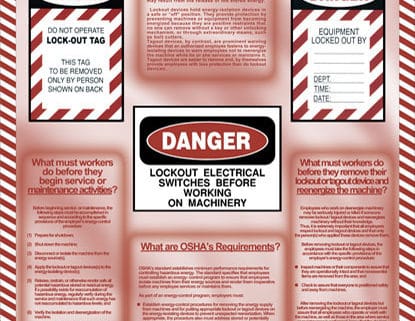Lockout/Tagout Informational Poster
Full Color Motivational Safety Poster 18″ x 24″ Laminated
DANGER DO NOT OPERATE LOCK-OUT TAG
THIS TAG TO BE REMOVED ONLY BY PERSON SHOWN ON BACK
What is lockout / tagout?
“Lockout / Tagout” refers to specific practices and procedures to safeguard employees from the unexpected energization or startup of machinery and equipment, or the release of hazardous energy during service or maintenance activities. If the potential exists for the release of hazardous stored energy or for the reaccumulation of stored energy to a hazardous level, the employer must ensure that the employee(s) take steps to prevent injury that may result from the release of the stored energy.
Lockout devices hold energy-isolation devices in a safe or “off” position. They provide protection by preventing machines or equipment from becoming energized because they are positive restraints that no one can remove without a key or other unlocking mechanism, or through extraordinary means, such as bolt cutters.
Tagout devices, by contrast, are prominent warning devices that an authorized employee fastens to energy-
isolating devices to warn employees not to reenergize the machine while he or she services or maintains it.
Tagout devices are easier to remove and, by themselves provide employees with less protection than do
lockout devices.
DANGER EQUIPMENT LOCKED OUT BY DEPT. TIME: DATE:
DANGER LOCKOUT ELECTRICAL SWITCHES BEFORE WORKING ON MACHINERY
What must workers do before they begin service or maintenance activities?
Before beginning service or maintenance, the following steps must be accomplished in sequence and according to the specific provisions of the employer’s energy-control procedure:
(1) Prepare for shutdown;
(2) Shut down the machine;
(3) Disconnect or isolate the machine from the energy source(s);
(4) Apply the lockout or tagout devices(s) to the energy-isolating device(s);
(5) Release, restrain, or otherwise render safe all potential hazardous stored or residual energy. If a possibility exists for reaccumulation of hazardous energy, regularly verify during the service and maintenance that such energy has not reaccumulated to hazardous levels; and
(6) Verify the isolation and deenergization of the machine.
In Appendix A to 1910.147, OSHA provides a Typical Minimal Lockout Procedure for employers to consult when preparing their own specific energy-control procedures.
What are OSHA’s Requirements?
OSHA’s standard establishes minimum performance requirements for controlling hazardous energy. The standard specifies that employees must establish an energy- control program to ensure that employees isolate machines from their energy sources and render them inoperative before any employee services or maintains them.
As part of an energy-control program, employers must:
● Establish energy-control procedures for removing the energy supply from machines and for putting appropriate lockout or tagout devices on the energy-isolating devices to prevent unexpected reenerization. When appropriate, the procedure also must address stored or potentially reaccumulated energy;
● Train employees on the energy-control program, including the safe application, use, and removal of energy controls; and
● Inspect these procedures periodically (at least annually) to ensure that they are being followed and that they remain effective in preventing employee exposure to hazardous energy.
If employers use tagout devices on machinery that can be locked out, they must adopt additional measures to provide the same level of employee protection that lockout devices would provide. Within the broad boundaries of the standard, employers have flexibility to develop programs and procedures that meet the needs of their individual workplaces and the particular types of machines being maintained or serviced.
What must workers do before they remove their lockout or tagout device and reenergize the machine?
Employees who work on deenergize machinery may be seriously injured or killed if someone removes lockout / tagout devices and reenergizes machinery without their knowledge. Thus, it is extremely important that all employees respect lockout and tagout devices and that only the person(s) who applied these devices
remove them.
Before removing lockout or tagout devices, the employees must take the following steps in accordance with the specific provisions of the employer’s energy-control procedure:
● Inspect machines or their components to assure that they are operationally intact and that nonessential items are removed from the area; and
● Check to assure that everyone is positioned safely and away from machines.
After removing the lockout or tagout devices but before reenergizing the machine, the employer must assure that all employees who operate or work with the machine, as well as those in the area where service or maintenance is performed, know that the devices have been removed and that the machine is capable of being reenergized. (See Sections 6(e) and (f) of 29 CFR Part 1910.147 for specific requirements.)



